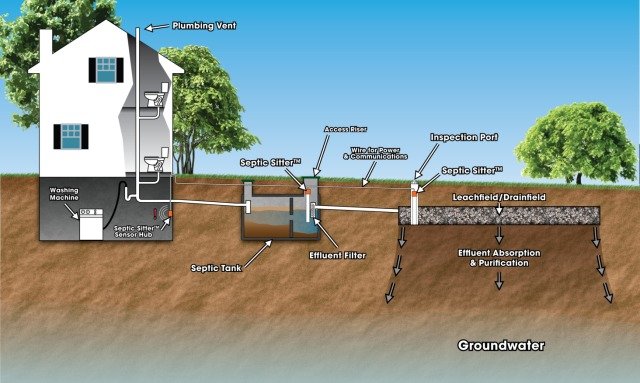How a Septic System Works (Conventional and Engineered)
Understanding a Septic System
Bacteria are what makes a septic system work. They break down waste, leaving water clean enough to safely percolate down into the earth. The whole system is designed to keep bacteria healthy and busy. Some live in the tank, but most do their work in the drain field.
1. All waste flows to the septic tank.
2. Watery waste, called “effluent,” fills most of the tank. Anaerobic bacteria begin breaking down the organic material in the effluent.
3. A layer of sludge falls to the bottom. Sludge is composed of inorganic solids and the byproducts of bacterial digestion.
4. A layer of scum floats to the top. Scum is primarily composed of fats, greases and oils.
The septic tank acts like a settling pond. Greases and oils float to the top. Heavier solids sink to the bottom.
5. A filter prevents most solids from entering the outlet pipe.
6. Effluent flows to the drain field.
The drain septic field provides a large area where bacteria can thrive and treated water can seep into the ground.
7. Holes in the drain septic field pipe allow effluent to seep into surrounding gravel.
Gravel around pipes allows water to flow into soil and oxygen to reach bacteria.
8. Aerobic bacteria in gravel and soil complete decomposition of the waste.
9. Clean water seeps down into the groundwater and aquifer.
Don’t abuse the system
A septic system that was properly designed and installed needs only occasional ‘pumping’ to remove the sludge and scum from the tank. But without knowing how does a septic tank work, you can do things that harm—or destroy—the system.
Waste that decomposes slowly (or not at all) gets flushed down drains. Cigarette butts, diapers and coffee grounds often cause problems.
If used heavily, garbage disposers can send too much solid waste into the system.
Lint from synthetic fibers flows from washing machines. Bacteria in the tank and drain septic field can’t break it down.
Household chemicals like disinfecting cleaners and antibacterial soaps kill bacteria. Most systems can handle light use of these products, but the less you use them, the better.
Too much wastewater over a short period of time flushes out the tank too rapidly.
Too much sludge reduces bacteria’s ability to break down waste. Excess sludge can also overflow into the drain field.
Sludge or scum plugs holes in the pipe.
Roots from trees and shrubs can clog and damage a drain field.
Compacted soil and gravel block seepage of effluent and deprive bacteria of oxygen. This is often caused by cars driving or parking on the drain field.
Flush semi or non-biodegradable items into septic tank, including paper towels, newspapers, writing paper, rags, disposable diapers, or cat litter.
Wash down sides of septic tank when it is pumped. The remaining slime contains bacteria which will be needed to digest the wastewater.
Flush large amounts of chlorine bleach or lye products into the septic tank. However, normal household use will not harm the bacteria.
Pour used motor oil into the septic tank.
Discharge brine (salt water) waste from self-regenerating water softeners to the septic tank. The high salt concentrations will clog the soil pores.
Connect roof drains and yard drains to septic tanks. Extra water will flood the tank and the leach field.
Construct leach field in close proximity to another leach field. The soil will become too saturated and both systems will fail.
Plant small or medium-sized trees within ten feet of leach fields, or large-sized trees within 20 feet of leach fields. (Roots will clog the pipelines).
Plant vegetation which requires excessive amounts of water on top of the leach filed.
Drive vehicles or place heavy objects, such as portable swimming pools, over septic tanks and leach fields.
What is an Engineered Septic System
An engineered septic system is often used in cases where a conventional septic system cannot be installed.
Septic systems are still possible on properties with soil that does not percolate, but these engineered septic systems often require additional earth-moving and/or pumping systems (percolate refers to how quickly water passes through the soil). The basic three limiting factors on the placement of the septic system are the ground water table, bedrock, and local health ordinances. The local health department may require an engineered septic system when the soil or ground water conditions are not ideal. They can also be required when the field is located uphill from the home. Most engineered systems include a pressure distribution, or pumping, system.
Cost?
General estimates for a Conventional septic system can run between $10,000 and $12,000 while an engineered system can go between $20,000 and $25,000. Again, these are estimates and can vary depending on other factors.
Call me with any additional questions you may have
313-598-0875


